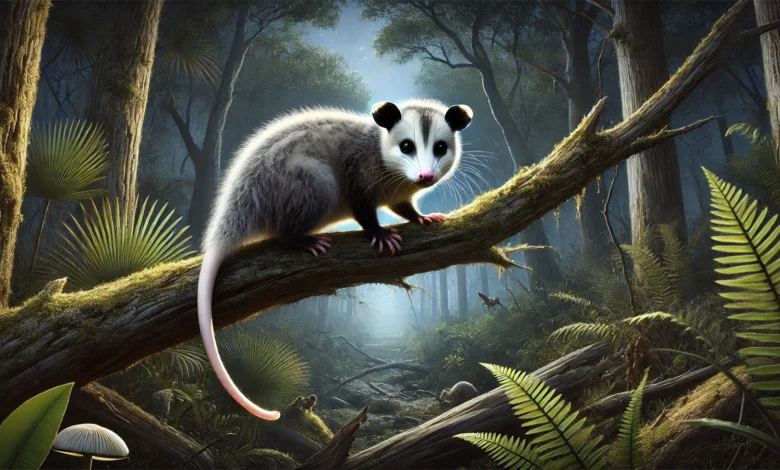Tñacuache: Discover the Fascinating Power of This Unique Animal

The tñacuache, often referred to as the opossum, is a fascinating creature that has earned its place in the wild landscapes of the Americas. Though not as well-known as some other animals, the tñacuache possesses an intriguing set of behaviours and biological features that make it unique. This animal is resilient and remarkable, from its marsupial nature to its survival instincts. In this article, we’ll explore the world of the tñacuache, offering insights into its lifestyle, diet, behaviour, and more while addressing some common questions surrounding this elusive creature.
What is a Tñacuache?
The term “tñacuache” is commonly used in Latin America, particularly in Mexico, to describe the opossum, a marsupial native to the Americas. The scientific name for the most common species found in the Americas is Didelphis virginiana, although there are over 100 species within the opossum family. Tñacuaches belong to the family Didelphidae, making them one of the few marsupials outside Australia.
Opossums are small to medium-sized animals, typically measuring around 60 to 90 cm (24 to 35 inches) in length, including their long, prehensile tail. They are nocturnal creatures and are particularly adapted to life on the ground and in trees, depending on the species.
The Tñacuache’s Unique Features
- Marsupial Reproduction
- Like other marsupials, the tñacuache has a unique way of giving birth. Females have a pouch where their underdeveloped young continue to grow after birth. After mating, the female will give birth to tiny, undeveloped offspring, which will crawl into the pouch to nurse. The young remain in the pouch for several weeks before emerging to continue growing on the mother’s back.
- Prehensile Tail
- One of the most distinguishing features of the tñacuache is its prehensile tail. This tail is not just for balance; it functions like a fifth limb, allowing the animal to grasp objects and trees and even hang from branches. This makes the tñacuache highly agile and capable of quickly navigating through trees and other obstacles.
- Impressive Immune System
- Tñacuaches are known for their remarkable immune system. They can survive bites from venomous snakes, such as copperheads and rattlesnakes, thanks to their resistance to certain types of venom. Additionally, they are known to carry bacteria like Leptospira but do not show disease symptoms, making them a potential vector for various infections in other animals.
Diet and Feeding Habits
Tñacuaches are omnivores with a wide-ranging diet that includes plant and animal matter. They are opportunistic feeders who eat whatever is available, including fruits, insects, small animals, birds, and eggs. Their diet can also consist of carrion, making them an essential part of the ecosystem as scavengers.
Their ability to adapt to different food sources is critical to their survival. In urban areas, for example, tñacuaches often scavenge garbage and food scraps, which is one reason they are frequently seen around homes and urban parks. Despite this, their natural diet in the wild includes things like roots, nuts, and even small reptiles.
Behavior and Survival Strategies
The tñacuache is a solitary and nocturnal animal, which means it is most active during the night. Its primary survival strategy revolves around its ability to adapt to various environments. Here are a few behaviours that help the tñacuache thrive:
- Playing Dead (Thanatosis)
- One of the most famous survival strategies of the tñacuache is its ability to play dead when threatened, a behaviour known as thanatosis. When confronted by a predator, the tñacuache will collapse, release a foul-smelling odour from its anus, and appear lifeless. This technique can confuse predators long enough for the animal to escape. It’s believed that the smell of decay deters carnivores from consuming the tñacuache.
- Climbing and Hiding
- Although opossums are often associated with scavenging on the ground, they are also excellent climbers. They use their prehensile tail and sharp claws to scale trees, fences, and other structures. Their ability to retreat into the treetops or hidden spaces provides them an escape route from predators.
- Territorial Behavior
- While tñacuaches are solitary, they do establish territories. These territories are often marked by scent markings and are defended from other opossums. They are not particularly aggressive animals but will fight if necessary to protect their home range.
Habitat and Distribution
Tñacuaches are highly adaptable and can live in various habitats, from forests and woodlands to urban areas. They are found throughout North, Central, and South America, with the Virginia opossum (Didelphis virginiana) being the most widespread species. In urban environments, they are commonly found in parks, alleys, and under porches or buildings, where they can find shelter and food.
In rural areas, tñacuaches often inhabit forests, grasslands, and wetlands, where they nest in hollow trees, burrows, or dens made from dense vegetation. Their adaptability to wild and urban environments has allowed them to survive in regions with varying climates.
The Importance of the Tñacuache in Ecosystems
Though often considered pests due to their scavenging habits, tñacuaches play an essential role in maintaining the balance of ecosystems. As omnivores and scavengers, they help control insect and rodent populations while also preventing the spread of carrion by consuming dead animals. Their role as prey for larger predators also contributes to the food chain, and their diverse diet ensures that they are a vital part of the ecological web.
Tñacuaches and Humans: Myths and Realities
Despite their important ecological role, tñacuaches have garnered negative attention, especially in areas near human settlements. Many people view them as nuisances because they tend to rummage through garbage cans and eat household pet food. However, most tñacuaches are shy and would rather avoid humans than confront them.
Common Myths About Tñacuaches
- Tñacuaches Carry Rabies
- While it is true that any mammal can potentially carry rabies, tñacuaches are less likely to be infected with the virus than other animals, such as raccoons or bats. They have a naturally low body temperature, which makes it difficult for rabies to survive in their system.
- Tñacuaches Are Dangerous
- Tñacuaches are generally not dangerous to humans. They are not naturally aggressive and will typically flee when encountering a human. They may bite if cornered in rare cases, but this behaviour is a last resort.
Frequently Asked Questions About Tñacuaches
1. How long do tñacuaches live?
Tñacuaches typically live between 2 to 4 years in the wild, although their lifespan can be shorter due to predation, disease, or accidents. In captivity, they can live up to 7 years.
2. Are tñacuaches good pets?
While tñacuaches can be kept as pets in some areas, they are not ideal for domestic life. They require a specialized diet and space to roam and can be difficult to care for due to their nocturnal and solitary nature. They are best appreciated in the wild.
3. Why do tñacuaches play dead?
Tñacuaches play dead as a defence mechanism. By pretending to be dead and releasing a foul odour, they avoid becoming prey for predators. This behaviour confuses and deters many potential threats.
4. Can tñacuaches carry diseases?
Tñacuaches can carry certain diseases, such as leptospirosis, but they are not significant vectors for diseases affecting humans. Handling them carefully is essential, as they can carry parasites like fleas and ticks.
Conclusion
The tñacuache, or opossum, is a unique and resilient animal adapted to various environments across the Americas. With its impressive survival strategies, such as playing dead and its ability to climb trees and scavenge for food, it thrives in urban and rural areas. While humans may not always appreciate them, tñacuaches are an essential part of the ecosystem, helping to control insect and rodent populations and contributing to the overall health of their environments. Understanding and respecting these fascinating creatures is vital to appreciating their role in the natural world.




